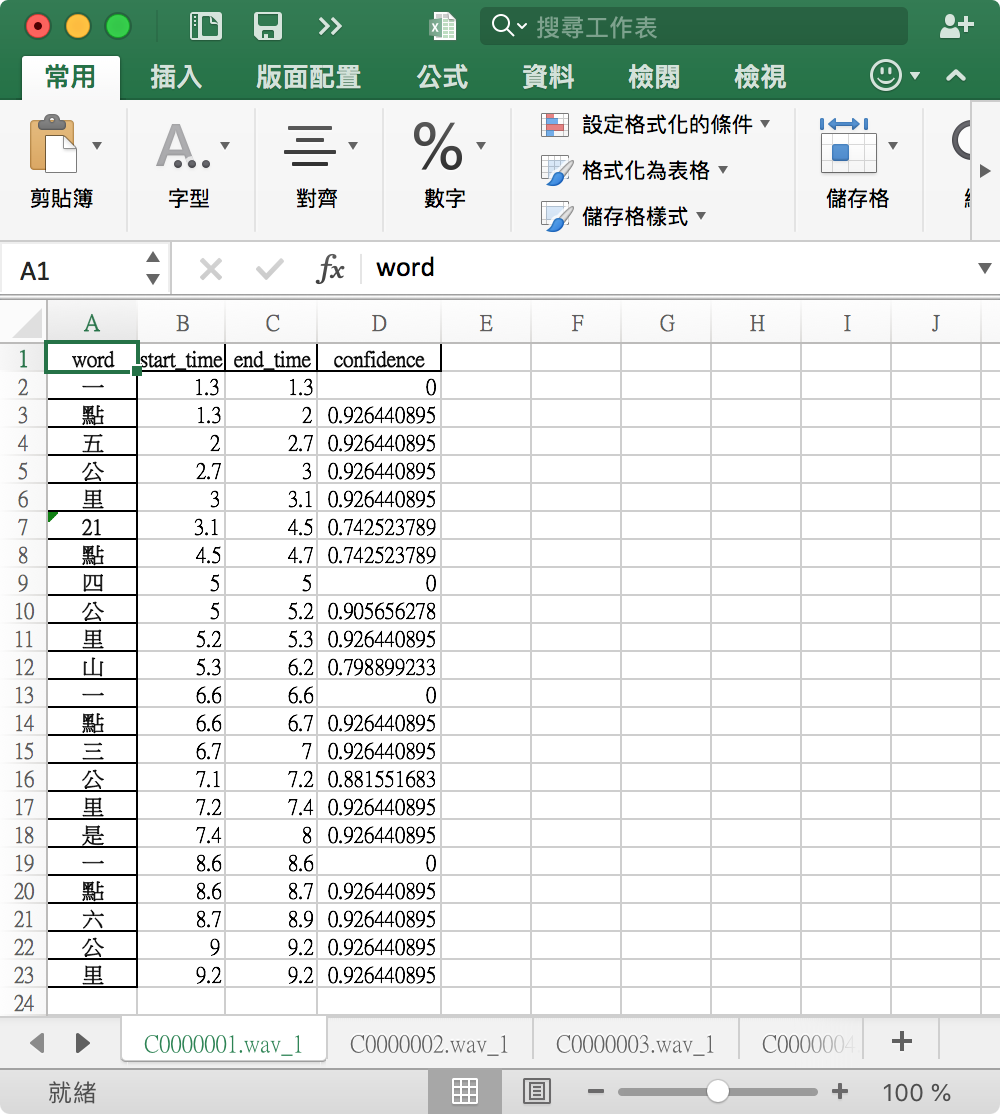Parse Recognition Response and Save Result to excel file
092 _, filename = parse_filepath(speech_file)
093 n = re.match(r'C(.+)\.wav', filename)
094 audio_index = n.group(1)
095 results = []
096 for i, result in enumerate(response.results):
097 alternative = result.alternatives[0]
098 print(u'Transcript {}_{}: {}'.format(audio_index, i+1, alternative.transcript))
099 results.append(alternative.transcript)
100
101 word_index = []
102 start_time_column = []
103 end_time_column = []
104 confidences_list = []
105 for word_info in alternative.words:
106 word = word_info.word
107 start_time = word_info.start_time
108 end_time = word_info.end_time
109 word_index.append(word)
110 start_time_column.append(start_time.seconds + start_time.nanos * 1e-9)
111 end_time_column.append(end_time.seconds + end_time.nanos * 1e-9)
112 if hasattr(word_info, 'confidence'):
113 confidences_list.append(word_info.confidence)
114 else:
115 confidences_list.append(float('nan'))
116
117 df = pd.DataFrame({'start_time':start_time_column, 'end_time':end_time_column, 'confidence':confidences_list}, index=word_index)
118 #print(df)
119 df.index.name = 'word'
120 df.to_excel(timestamp_writer,'{}_{}'.format(filename, i+1))
行92~94是從原始檔案路徑取出音頻編號的資訊(e.g. /Users/petertsai/Google 雲端硬碟/gitbook_figure_python_code/choice(entire)/C0000001.wav 取出 0000001)。
行95 初始一個空列表(list)的變數results,用來儲存轉譯的句子。
行96~120是一個for loop,loop的對象是google speech-to-text api的response.results。
response.results是轉譯的結果,因為google speech-to-text api會自動把超過1秒間隔的部分分開,當成新的句子,所以response.results可能會超過一個。
由於kaggle比賽的語音資料,每個選項間隔因人而異,沒有都超過1秒,所以沒辦法直接用google speech-to-text api做sentence segmentation。
行97取出每個result裡的alternatives[0],因為每個句子google可能會轉譯出不同的結果,alternatives[0]代表google覺得最有可能的結果,我們只使用這個結果,捨棄其他的選項。
行98把alternative.transcript的結果顯示在螢幕上,並標明是哪個音頻的第幾個段落。
行99把alternative.transcipt加到results列表裡面。
行101-115,程式把alternative.words的資訊word_info,裡面包含
word單字結果start_time單字開始的時間end_time單字結束的時間cofidence單字結果的信心指數(0~1)
這些資訊會分別存到word_index,start_time_colum, end_time_column, confidence_list列表裡,目的符合pandas.dataframe的格式。
因為在beta版裡面才有word confidence value,所以行112-115當confidence property不存在的話,就把nan填入confidence_list。
 圖1
圖1 transcribe_timestampbeta_01.xlsx檔案格式示意圖,裡面有25頁面,每個頁面的名稱為<音頻檔名>+<段落編號>,每頁裡面第一行是轉譯的單字(word),第二行是每個單字開始的時間(start_time),第三行是每個單字結束的時間(end_time),第四行是每個單字的信心指數,越接近1表示辨識越準確。
行117建立一個pandas.dataframe把word_index,start_time_colum, end_time_column, confidence_list當成df dataframe的一欄,如圖1所示。
行119把word_index上標標註'word',方便讀者閱讀。
行120把df透過to_excel函數存成xlsx檔。